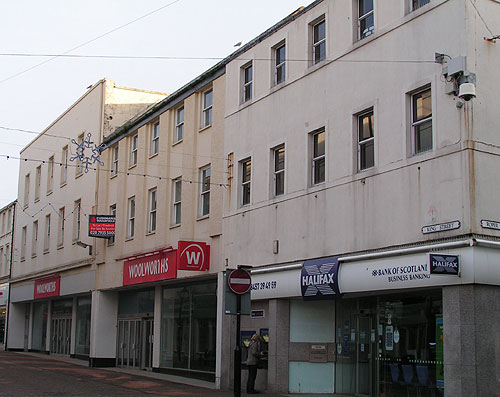
King Street had started its development before the death of Christopher Lowther in 1644 but was then known as Custom House Street. By the time his son, Sir John Lowther, named the street King Street in 1687, James II was on the throne. By 1700 the street was completely occupied and most of the side furthest from the sea had been for over 15 years.
Somewhere on this street one of the greatest marine painters was born. Probably now more famous in America, Robert Salmon had a father called Francis Solomon who was a jeweller and silversmith with a shop on King Street.
At street level very little in the architecture gives the impression of any antiquity as modern shop-fronts have obliterated any earlier features. However, the next storey tells a different story. Many of the shops appear to be built into the base of Georgian town houses and many of the original plots have remained the same size. In some cases, plots have been combined and completely rebuilt to house the larger modern stores.
The photos of King Street were taken at the end of 2009 - it will be interesting to see how many shops are the same in a year's time.

The big casualty this year was obviously Woolworths which occupied the largest area of space on King Street. The shop went through to Roper Street but squeezed in HBOS on the corner. It failed on a national basis partly due to the credit crunch but mainly because it had lost its market. Downloads had replaced record sales and the household goods were done better and cheaper by new supershops such as Wilkinsons and B&M which also have a strong presence in Whitehaven. Changing all the aisles to face diagonally so you couldn't get to where you wanted couldn't have helped!
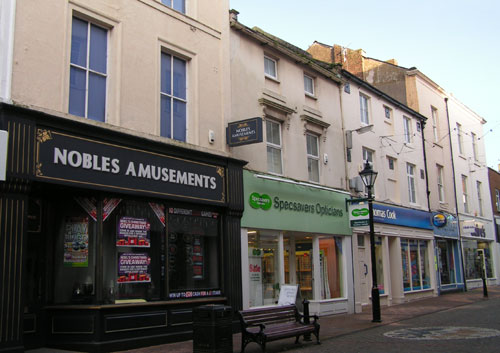
Across the road Nobles Amusements, Specsavers and Thomas Cook all occupy more traditional Whitehaven shops which appear to be converted Georgian houses. This dates back to when shopkeepers were often family businesses living above the shop and producing goods or storing them in warehouses at the back. In fact a look round the back on Strand Street shows that some of these warehouses still remain.
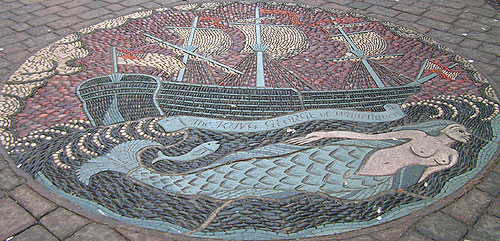
King Street had pavements down either side and a road down the centre for many years but is now entirely paved and this gave the opportunity to add some street furniture and several works of art. These pebble mosaics by Maggy Howarth were inspired by other such mosaics that in the past were found around Whitehaven. The King George illustrated floating above the mermaid is thought to be the ship John Paul Jones served on as third mate as a young sailor in Whitehaven. It was also the slave ship celebrated by the largest of the enamelled Beilby Goblets, one of the finest pieces of glassware from the 18th century now on show at the Beacon heritage centre.
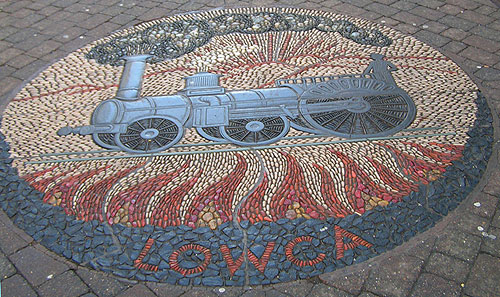
Another of the mosaics illustrates the Crampton locomotive which was made at the Lowca engineering works just up the coast. This factory owned by Tulk and Ley developed the first Crampton locomotives between 1845-1847 which had a distinctive single pair of large driving wheels and was designed with a low centre of gravity to improve stability on a narrow gauge at speed. The design was adopted more in the United States and in Europe than in Britain. The company was later take over by Fletcher, Jennings and Co. with total production heading towards 200 locomotives by the end of the century.
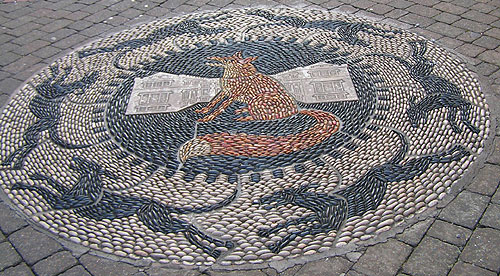
Another roundel features a fox in front of Whitehaven castle encircled by running hounds. This comes from the fact that the best surviving original mosaic is the one in the castle courtyard of a fox and hounds.
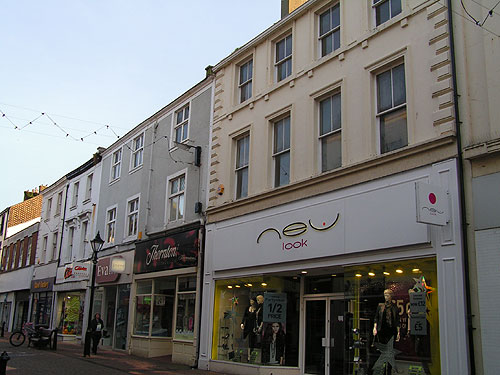
Above New Look fashion store the facade looks as though it was once a fine building with sculpted corner stones and bracketed window sills. Beyond that Thorntons choc shop and Evans boutique have a plainer frontage and were built around 1700. Before that the site had been a Custom House from 1684-1694 which had occupied a mansion that Thomas Britton had built by 1669. The house occupied by Clinton Cards can be dated to 1766 by the rainwater head at the top of the drainpipe.
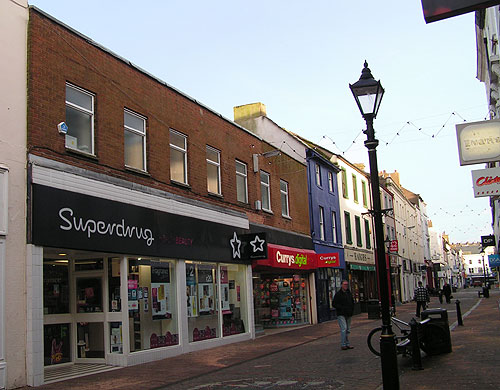
The plot now occupied by Superdrug and Currys Digital shows the disaster which was averted by the lack of funds for redevelopment in the 1970's. This is one of the plots that was re-developed and suffered as a result with a building that could be just as easily in Swindon as Whitehaven.
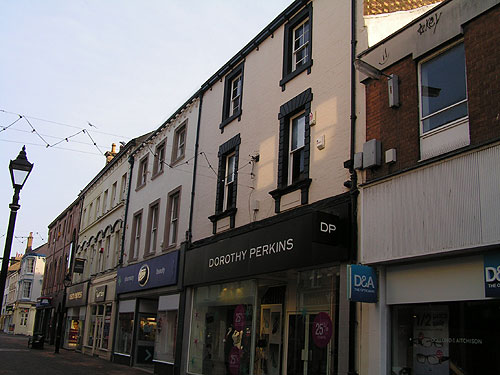
The building across the road currently occupied by the opticians Dolland and Aitchson suffered the same fate but the rest of the buildings to Lowther Street have retained their individuality within a general Whitehaven character. Dorothy Perkins have matched their black and white logo with the paintwork of the rooms above. The second storey has rusiticated window surrounds which have large panes of glass rather than the more authentic quartered ones above.
From 1774-1882 The Cumberland Pacquet Newspaper was printed and sold from the building now occupied by Boots the Chemist. Originally printed by John Ware & Sons they also had the distinction of printing the first bible translated into Manx. This three volume set almost had a disaster when the manuscript for the second volume was involved in a shipwreck and was only saved by the Rev. Kelly valiantly holding it above the water for 5 hours.
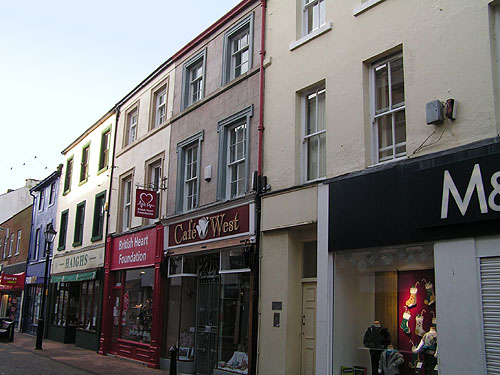
After Currys we have Food then Haighs the butchers, British Heart Foundation charity shop, and Cafe West all occupying traditional 3 storey shops. Cafe West which goes right through to Strand Street has been particularly well restored with the upper windows with delicate mouldings and smaller panes looking quite elegant.
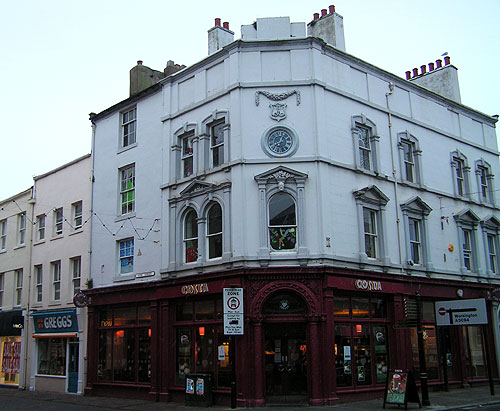
After Greggs pastry shop we have on the corner Costa coffee shop which occupies a very fancy building on the corner with Lowther Street. The 19th century mouldings in the Italienate style decorate an 18th century building. This was once the Canterbury Inn and later a piano and organ salons which had a licence to sell Broadwood pianos in an age when people made their own entertainment and no self-respecting middle class parlour would be without one. It later became the National Provincial bank.
Originally King Street continued across the end of the Lowther Street on this side and a small lane provided access to East Strand Street around about where Greggs is. Later the road was opened up through to New Lowther Street by removing buildings from this side in the early 18th century.
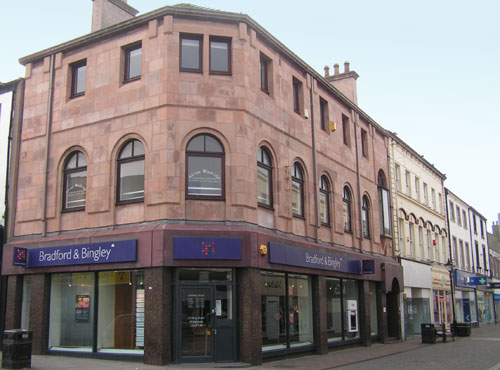
The Bradford & Bingley building society is a more modern looking building but one that has been designed to fit within the existing street design. The arched windows appear to pick up on the curved eyebrows of the windows beyond and the sandstone facing gives it the solid dependable look required of a banking institution. This replaced an earlier Italianate style building that was Edgard's and before that the London and Manchester Warehouse.
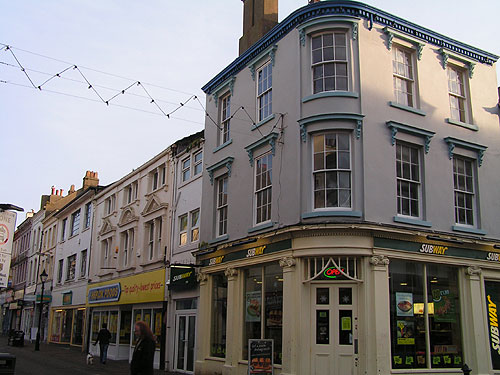
Across Lowther Street we have another rather elegant corner building now occupied by Subway but at one time Fleet's grocers. The curved sash windows on the corner are an unusual feature. It is nice to see that Subway have kept their logos small and within the existing freeze on the building to maintain the original nature of the facade.
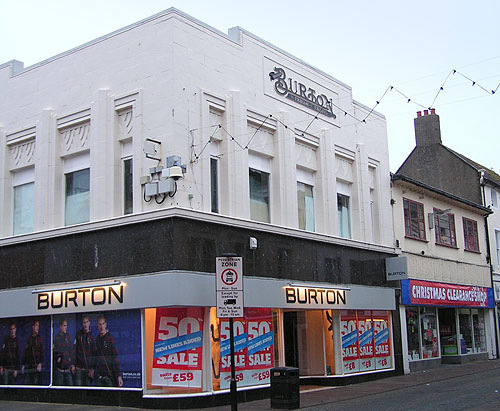
Burton's on the corner of King Street and Lowther Street is one of a few Art Deco buildings in Whitehaven, built in 1938. Although not exactly in keeping with Georgian Whitehaven the the style is confident and exudes a grandeur befitting this prominent corner plot. It still carries the original Montague Burton logo on a plaque high above the more modern lettering. Before Burtons site was occupied by George Cowin's shop which was more ornate with a corner entrance to match the others. This and the site beyond had been the Black Lion Inn one of Whitehaven's main coach stops.
Next to the Black Lion in the early 19th century was a bank owned by Raney, Hope and Johnston. The property stretched through to Strand Street, at the back, where they had warehouses. The bank failed due to a market collapse when in 1826 a panic on the London money market caused a run on the London Banks. This King Street bank followed suit as it used those in London as surety. This all sounds very familiar in 2009. The upshot was that Raney who had got out early lost his money in legal battles with his former partners. He then emigrated to America to rebuild his life in the land of opportunity but died soon after. However, one of his daughters married the son of an American President the other, Ann Raney, kept memoirs of her eventful life which were published in 1971 as Victorian Lady on the Texas Frontier. At one point Ann returned to Whitehaven to clear her father's name and fight for his money but she returned to America and died quite poor.
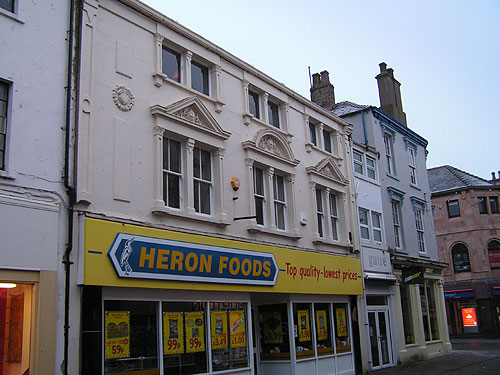
If you can raise your gaze above the large modern signage of Heron Foods there is a set of magnificent window surrounds on the second storey. This was for many years Mark Taylor's that many will fondly remember as a large toy shop that also sold tools, and bikes from the back on Church street, although in 1901 Mark Taylor was listed as a hairdresser at this address.
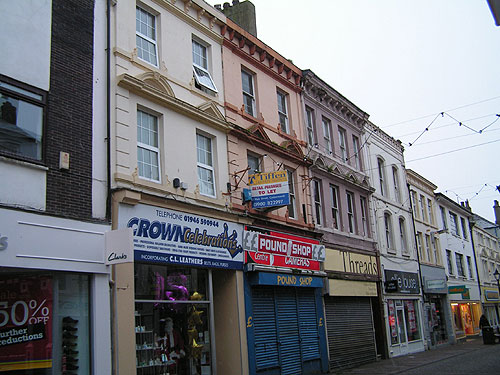
The next three shops appear to have been built around the same time. When we study the ornamentation above the second storey windows it continues across the three properties.
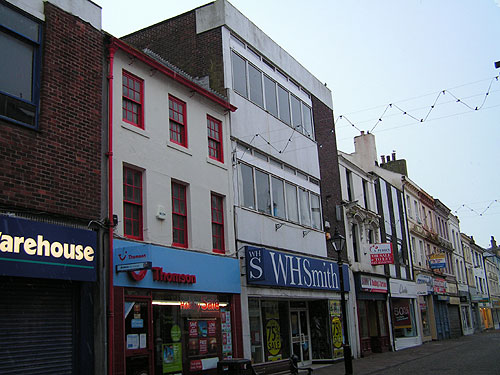
Since the early years of the 20th century WH Smith used to have the shop across the road latterly occupied by Cowpes but moved into this more modern building in 1978 as it provided much more spacious accommodation. Being built for purpose it is one of the few shops on King Street that uses the second storey for customers but the facade does nothing to complement the street.
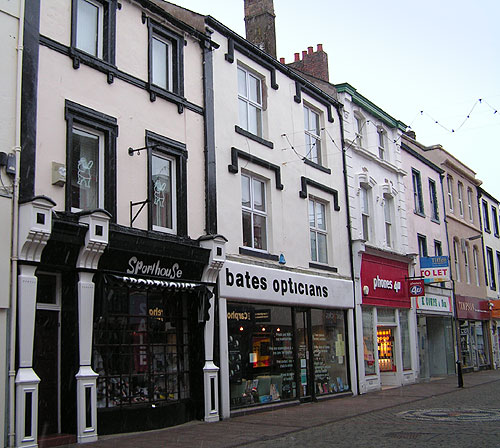
Sporthouse has a Victorian style curved shop window which is a modern reproduction. Fluted pilasters surrounding the door and window, that look more like a piece of furniture, are from its former existence as the Prince Albert pub. This is followed by Bates opticians and Phones 4U both occupying traditional buildings.
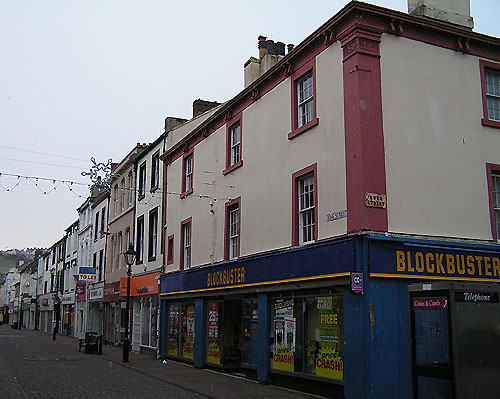
At the top end of the street is Blockbuster video which occupies part of what was once the Globe Hotel. Before the advent of the steam train the Globe Inn along with the Black Lion and the Golden Lion all along King Street were the principal inns from which horse-drawn coaches and carriers left town. Two hundred years ago when Mrs Mary Wild ran the Globe a coach called the Royal Sailor left for Carlisle every day at 5.00am and returned twelve hours later. Four carriers also departed for Ulverston, Cockermouth, Workington and north to Carlisle, Edinburgh and Newcastle. The Globe was also the meeting place for the Holy Cross Chapter of the Masons and the Concord Lodge.
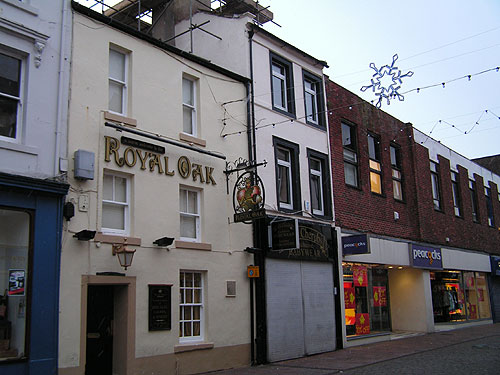
The Royal Oak as may be judged from the modest appearance is one of the older buildings on King Street and dates back to the 1680's. It has just had a makeover and the sign has changed from the crown in a tree painted on wooden board to a more ornate metal sign. At one time there was also a Royal Oak near the bottom of Queen Street.
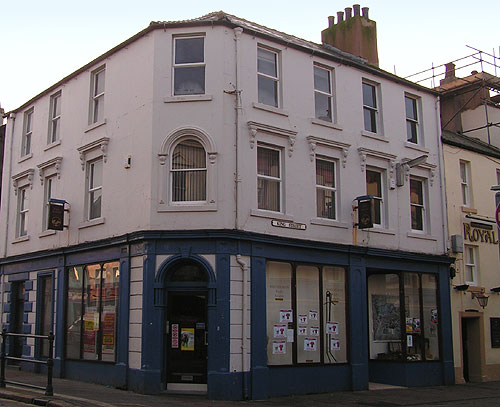
At the meeting of King Street and Duke Street we have another satisfying corner building with the entrance across the apex being an arched top doorway which is mimicked by the arched window above. Now a betting shop this was for many years Davies the Chemists but lettering in the fanlight indicates that during the Second World War it served as a canteen for the forces operating in the town.
© WAWL 2009